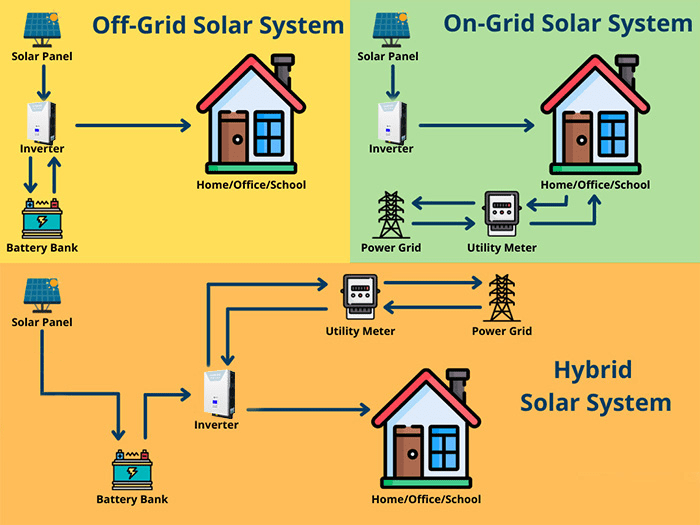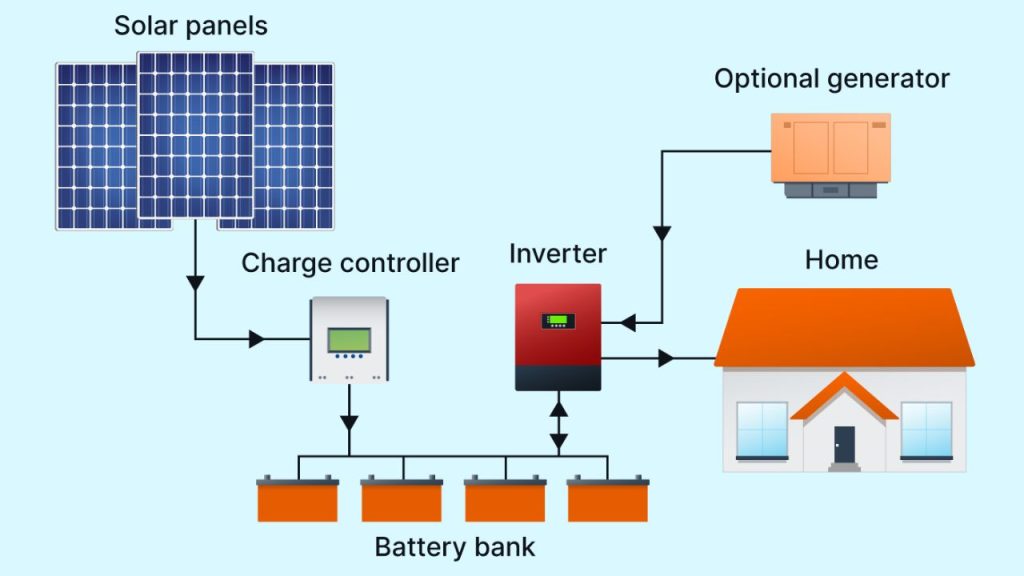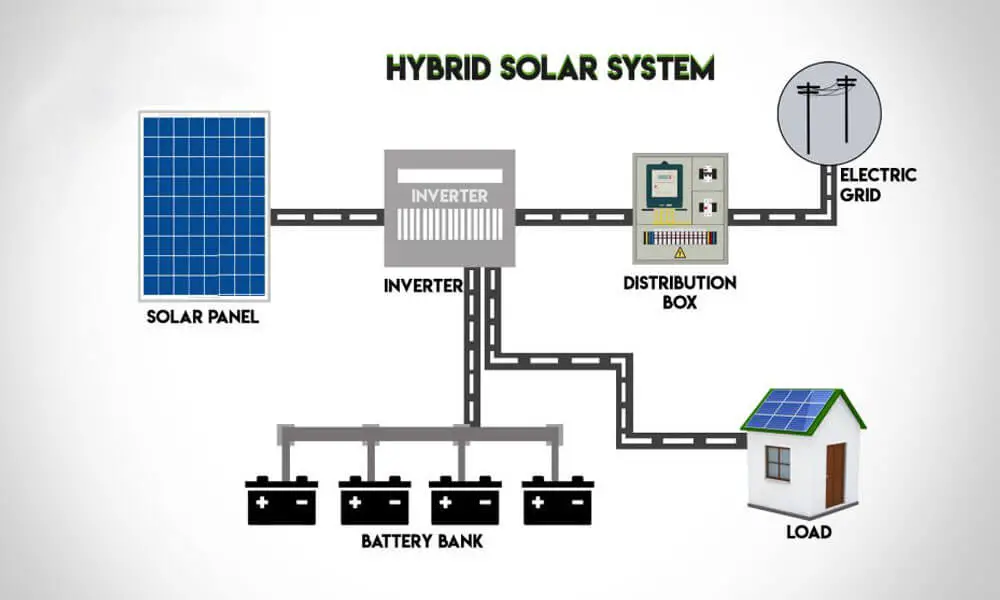Solar Power System: On-Grid VS Off-Grid VS Hybrid

Difference Between On-Grid VS Off-Grid Vs Hybrid Solar Power System
Introduction – Solar power System emerges as one of the best sustainable power sources because of its combination of high affordability and practicality. You need to recognize the distinctions among On-Grid, Off-Grid, and Hybrid solar power systems to select the optimal system when you plan to install one. This article investigates the divergent features of these systems while conducting an analysis on their installation expenses in India.

What is an On-Grid Solar Power System?
A technology compatible with grid-connected electricity systems functions through direct solar power application to the power distribution network. Users can extract electricity from solar panels in combination with grid power supply when necessary.
![on- Grid Solar System What is a Grid Connected PV System? [A Complete Guide]](https://waareeimages.s3.ap-south-1.amazonaws.com/On_Grid_Solar_System_5ef4461ffd.png)
Advantages of On-Grid Solar Power Systems
- Cost Effective: – The initial costs of off-grid systems are lower than the equivalent off-grid systems.
- Net Metering: – Householders who participate in Net Metering can transmit their surplus electricity to the power grid which generates energy credits that offset electricity payments.
- Less Maintenace: – The system needs minimal maintenance since it does not require battery components.
Disadvantages of On-Grid Solar power Systems
- No Backup Power: Does not work during power outages as it depends on the grid.
- Dependency on Grid: Cannot function in remote locations without grid access.
Initial Cost of On-Grid Solar Power System in India
- 1 kW System: ₹50,000 – ₹70,000
- 3 kW System: ₹1,50,000 – ₹2,00,000
- 5 kW System: ₹2,50,000 – ₹3,00,000
What is an Off-Grid Solar Power System?
The Off-Grid Solar System retains sole power management capabilities independent of grid power infrastructure. An Off-Grid Solar System generates power through solar panels which then transmit energy to batteries for storage thus providing uninterrupted electricity independent of electricity grids.

Advantages of Off-Grid Solar Power Systems
- Works in Remote Areas: Ideal for locations without access to the electricity grid.
- Backup Power: Provides electricity even during grid failures or load shedding.
- Energy Independence: Users are not reliant on utility companies.
Disadvantages of Off-Grid Solar Power Systems
- Higher Initial Cost: Batteries significantly increase installation expenses.
- Battery Maintenance: Batteries need regular maintenance and replacement over time.
- Limited Energy Storage: If battery storage is insufficient, power supply may be disrupted.
Initial Cost of Off-Grid Solar Power System in India
- 1 kW System: ₹90,000 – ₹1,20,000
- 3 kW System: ₹2,50,000 – ₹3,50,000
- 5 kW System: ₹4,50,000 – ₹6,00,000
What is a Hybrid Solar Power System?
The Hybrid Solar System provides functionality between traditional interconnected On-Grid and independent Off-Grid solar systems. The system functions with electric utility grid connectivity and maintains power storage ability using battery backup systems.

Advantages of Hybrid Solar Power Systems
- Reliable Power Supply: Works even during power outages, thanks to battery backup.
- Optimized Energy Use: Excess energy is stored in batteries and used when needed, reducing dependence on the grid.
- Net Metering Benefits: Can sell surplus power to the grid, lowering electricity bills.
Disadvantages of Hybrid Solar Power Systems
- Higher Installation Cost: Batteries and grid connectivity make this system expensive.
- Battery Maintenance: Like off-grid systems, batteries require regular upkeep.
Initial Cost of Hybrid Solar Power System in India
- 1 kW System: ₹1,00,000 – ₹1,50,000
- 3 kW System: ₹3,00,000 – ₹4,50,000
- 5 kW System: ₹5,00,000 – ₹7,50,000
Comparison Table: On-Grid vs Off-Grid vs Hybrid
| Feature | On-Grid | Off-Grid | Hybrid |
|---|---|---|---|
| Grid Connection | Yes | No | Yes |
| Battery Storage | No | Yes | Yes |
| Works During Power Cuts | No | Yes | Yes |
| Net Metering | Yes | No | Yes |
| Initial Cost | Low | High | Highest |
| Best For | Urban areas with stable grid | Remote locations | Areas with unreliable grid |
Which Solar Power System Should You Choose?
The On-Grid Solar System when you rely on steady power and need net metering to cut down electricity costs.
An Off-Grid Solar System is suitable for inhabitants of remote locations lacking grid connectivity who require total self-reliance regarding their power supply.
The Hybrid Solar System to access sanitation from backup power as well as generate surplus grid sales.
Government Incentives and Subsidies
- Through multiple incentive and subsidy programs Indian authorities encourage solar energy adoption across the nation.
- The Ministry of New and Renewable Energy (MNRE allows residential users to receive subsidies that cover up to 40% of their solar system installation costs.
- Through the Accelerated Depreciation Scheme manufacturers can deduct their solar energy system costs from their taxable income.
- Financial institutions that participate in PM-KUSUM and Surya Mitra Program provide on-grid solar installation loans at minimal interest rates.
- Through financial help institutions promote solar adoption by making on-grid solar installation more accessible to the general public.

PM – Surya Ghar: Muft Bijli Yojana
PM Surya Ghar: Muft Bijli Yojana the Government of India delivers free electricity to residential clients throughout the country. Prime Minister Narendra Modi started the PM Surya Ghar: Muft Bijli Yojana scheme on February 15th of 2024. Through the scheme Home-Owners can receive governmental discounts to purchase solar panels for rooftop installations. The government subsidy program will reimburse up to 40% of the total solar panel expenses. The program targets to provide free power benefits to 1 crore households spread throughout India. Free power scheme estimates approximately Rs. 75,000 crores in annual savings for the government during each year of operation.
Benefits
| Average Monthly Electricity Consumption (units) | Suitable Rooftop Solar Plant Capacity | Subsidy Support |
| 0-150 | 1-2 kW | ₹ 30,000/- to ₹ 60,000/- |
| 150-300 | 2-3 kW | ₹ 60,000/- to ₹ 78,000/- |
| > 300 | Above 3 kW | ₹ 78,000/- |
The benefits of the scheme include
- Free electricity for households.
- Reduced electricity costs for the government.
- Increased use of renewable energy.
- Reduced carbon emissions.
Conclusion
A solar power system purchase depends on three main variables including geographical location and available funds alongside power consumption requirements. The most affordable solar choice is an On-Grid system while Off-Grid systems deliver autonomy and Hybrid systems deliver dependable performance. Details about system differences and costs will help users pick a solution that matches their needs best.
Your selection of solar system enables you to cut power expenses and protect the environment and extend your energy peace of mind. The Indian government offers financial support for solar power installations which makes the present moment perfect to convert to solar energy.







